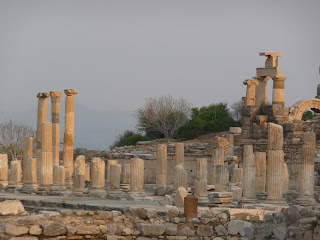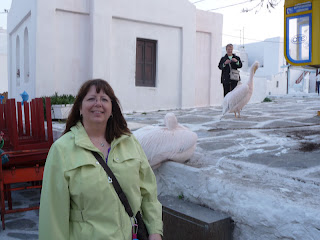March 27, 2012
We got up at 5:30 a.m. this morning. At 6:00 a.m. we went to breakfast. We got a little worried because no one else from our group was there - found out the wake up calls were late! At 6:50 a.m. we met for our excursion to Ancient Ephesus. At 7:00 a.m., our ship docked at the port in Kusadasi, Turkey. We met our guide, Julia. She took us on a wonderful tour of Ephesus. It was fantastic. Many of us wish we could have spent more time wandering around the ancient city.
On St. Paul's third mission (AD 52-56), he went to Ephesus (which is now in Turkey). It was the site of Paul's ministry for three years.
"In the ancient world, Ephesus was a center of travel and commerce. Situated on the Aegean Sea at the mouth of the Cayster River, the city was one of the greatest seaports of the ancient world. Three major roads led from the seaport: one road went east towards Babylon via Laodicea, another to the north via Smyrna and a third south to the Meander Valley." (bibleplaces.com) It was founded between 1500-1000 B.C. Ephesus was a coastal city with a population of 1/4 million. It became the second largest city of the Roman Empire. The city was destroyed by an earthquake in A.D. 17 and then rebuilt and enlarged by Tiberius.
As in Greece, there were cats everywhere!
The Varius Baths built in the 2nd century:
The Palace of the Council believed to have built by Emporer Augustus in the 1st or 2nd century AD. The upper construction belongs to the Roman Period and the lower part to the Hellenistic period. It was the place of the governmental body of the province.
The Odeon Theatre (or concert hall) was constructed in the 2nd century AD and seated 1500 people for plays and concerts.
The Memorial to Memmius, grandson to the dictator Sulla, was erected in the 1st century.
The Temple of Domitian (an emporer) contained warehouses and shops on the first floor and the temple on the 2nd floor.
Nike, the goddess of Victory, comes from the Roman Period.
Byzantine statue erected in honor of a woman doctor who did great service to her country.
The Heracles Gate, named this because of the relief of Heracles, the god of power and strength, dates back to the second century AD. The gate narrowed the access to the street, preventing the passage of vehicles. From the 4th Century, the street had become a pedestrian area.
The Fountain of Trajan was erected in the 1st century AD in dedication to Emporer Trajan. It was 2 stories high.
The Brothel that dates from the 4th century. Careful health control dominated the brothel.
5th century mosaic in a colonnade along the Street of the Curetes.
The Bath of Skolasticia: parts of it date back to the 2nd century. There was a swimming pool, a hot bath, a warm bath, a cold bath and a dressing room. There were public rooms and private rooms. People could stay for many days if they wished.
The Latrina (pubic toilets) was built in the 1st century. There was an entrance fee to use them. The toilets are aligned along the walls. There was a drainage system under the toilets. People would use this time at the toilets to socialize and discuss business matters. Hmmm...
I just loved some of the architecture in Ephesus.
The Library of Celsus was built by C. Julius in honor of his father in 135 A.D. The library was built to store 12-15,000 scrolls and to serve as a monumental tomb for Celsus. In a massive restoration which is considered to be very true to the historic building, the front facade was rebuilt during the 1960's and 1970's and now serves as a prime example of Roman public architecture.
Our Tour Group
The Agora was the shopping district. In the back, you can see the Library of Celsus. To the left, you can see 3 arches. These were the Mazeus and Mithriadates Gate. Then across the middle you can see the smaller arches - those are all the shops. I can just imagine Paul walking among the people in the Agora and preaching to them about Christ!
The Great Theater of the City was located at the western foot of Panayir Mountain. This has been unearthed year by year continuously. They are still working on it now. It had a capacity of 25,000 spectators. In the early years of Christianity, one of the big combats between followers of Artemis and of Christ had taken place in this theater. As a result of this, Paul was put into prison and then had to leave Ephesus.
The Harour (Arcadian) Street was the most important street in the city. The middle section was paved with marble and lined with columns. It was decorated with statues and illuminated with candle-like street lamps at night.
A few of the many, many cats of Ephesus!!!
Adaland, near Kusadsi, Turkey, is one of the best ten aquaparks of the world!
Hotels along the sea; hot resort area of Turkey
Kuşadası is a resort town on Turkey's Aegean coast. It has a residential population of 64,359 rising to over half a million during the summer. This area was founded in 3000 B.C.
This sculpture, Hands of Peace, is on the waterfront promenade in Kusadasi.
We stopped and watched them make Turkish carpets. It was pretty cool! The carpets are not made by weaving, they are individual knots! Amazing! I guess that is why they are so very, very expensive!!!
We had a little time to do some shopping in Kusadasi before heading back to the ship. The shopkeepers were extremely pushy which both Brenda and I absolutely hated! We did buy a few things, though.
Wouldn't you love to sip your Starbucks at a table here??? Wow!!!
Then it was time to head back to the ship. We got there at 11:10 a.m. and "all-aboard" was at 11:30 a.m. - plenty of time!



































































































